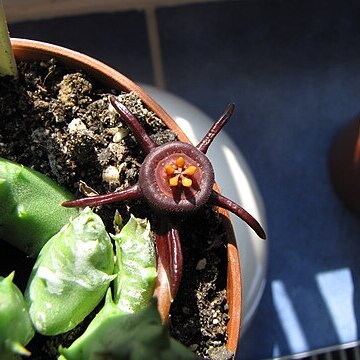Dwarf, mat-forming, glabrous succulent, up to 50 mm tall, stems leafless, 4-or 5-angled, tuberculate, 10-50 mm long. Flowers 1-3, developing in succession, in sessile clusters. Corolla rotate, 18-30 mm diam., dark brown, with raised annulus defining tube, lobes spreading, linear with down-turned margins, 9-15 x 3-5 mm. Corona pale brown, outer lobes disc-like, level with top, but not completely covering annulus, inner adpressed to anthers, with prominent, erect, dorsal appendage.
Dwarf, mat-forming, leafless succulent with 4-or 5-angled, tuberculate stems 1.0-1.5 cm long; sap clear. Flowers 18-25 mm diam., dark brown, with raised annulus, petals narrow with deflexed margins, finely pubescent, corona pale brown, disc-like but not completely covering annulus.
A succulent plant. The stems are succulent and they creep along the ground. They develop roots. The flowers are red and star shaped.

